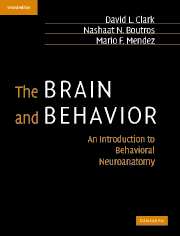Book contents
- Frontmatter
- Contents
- Preface
- 1 Introduction
- 2 Gross anatomy of the brain
- 3 Histology
- 4 Occipital and parietal lobes
- 5 Temporal lobe – neocortical structures
- 6 Frontal lobe
- 7 Basal ganglia
- 8 Diencephalon: hypothalamus and epithalamus
- 9 Diencephalon: thalamus
- 10 Brainstem
- 11 Limbic system: temporal lobe
- 12 Limbic system: cingulate cortex
- 13 Limbic system: overview
- 14 Interhemispheric connections and laterality
- Index
- Plate section
- References
13 - Limbic system: overview
Published online by Cambridge University Press: 25 August 2009
- Frontmatter
- Contents
- Preface
- 1 Introduction
- 2 Gross anatomy of the brain
- 3 Histology
- 4 Occipital and parietal lobes
- 5 Temporal lobe – neocortical structures
- 6 Frontal lobe
- 7 Basal ganglia
- 8 Diencephalon: hypothalamus and epithalamus
- 9 Diencephalon: thalamus
- 10 Brainstem
- 11 Limbic system: temporal lobe
- 12 Limbic system: cingulate cortex
- 13 Limbic system: overview
- 14 Interhemispheric connections and laterality
- Index
- Plate section
- References
Summary
The term limbic lobe was used by the French physician, Paul Broca, to designate the structures on the limbus or margin of the neocortex. These structures lie in a C-shaped arch on the medial and basilar surfaces of the cerebral hemispheres that surround the lateral ventricles (Figure 13.1). Broca defined the limbic lobe as the parahippocampal and cingulate gyri (le grand lobe limbique). In addition to the limbic cortex, a number of subcortical structures can be added to make up what is usually considered the limbic system. The subcortical structures include the hippocampus, the amygdala, and the septal nuclei. Depending on the author, the list of limbic structures can be expanded to include portions of the hypothalamus and thalamus, the habenula, the raphe nuclei, the ventral tegmental nucleus, the nucleus accumbens, the basal nucleus (of Meynert), the posterior frontal orbital cortex, and others (Trimble, 1991; Van Hoesen et al., 1996).
The limbic system works in collaboration with other brain systems. Therefore, a more complete theory of the function of the limbic system can be developed only in tandem with a more complete understanding of the entire brain. The limbic system provides the animal with a means of coping with the environment and with other members of the species found in that environment. More basic parts of the system are concerned with primal activities (i.e., food and sex), while others are related to feelings and emotions.
Information
- Type
- Chapter
- Information
- The Brain and BehaviorAn Introduction to Behavioral Neuroanatomy, pp. 223 - 238Publisher: Cambridge University PressPrint publication year: 2005
